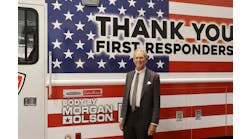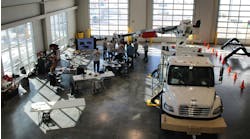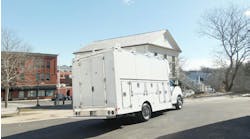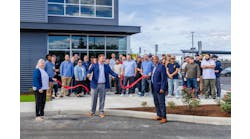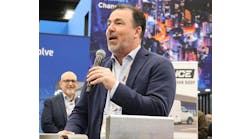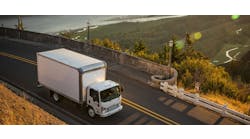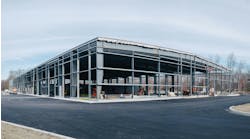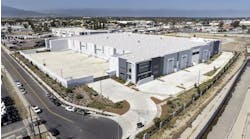When business started slipping for a Salt Lake City-based truck body manufacturer with a well-known brand, Pat Godwin saw an opportunity to extend his own brand in the West. But many in the industry familiar with the demise of Williamsen Manufacturing wondered if Godwin’s ability to turn around and grow struggling companies could meet the challenge. And after an initial visit in the spring of 2014, he admits to having had doubts about the prospects.
“We saw what they had done with the place and we were not interested,” he said.
So the founder of Dunn, NC-based The Godwin Group returned home, ready to look for other opportunities in the region. But the possibilities they’d seen in a Williamsen deal were such that the company leadership couldn’t let them pass easily.
“The same factors were in play. We were still looking to move westward and wanted to see if that potential was still there. We talked about it as a management team, and decided we’d all come out,” recalls The Godwin Group President Pat Godwin Jr. “When we left North Carolina, it was not our intention to pursue this any further—we just wanted to assure ourselves it was not what we wanted to do.”
The Godwin Group had made a run at what was then Tesco-Williamsen six years earlier, before backing off and allowing the subsequent owners to step in. But those owners shifted the focus from truck bodies to trailers, specifically to manufacturing custom military transportation equipment such as missile carriers to win lucrative federal contracts, explains Patrick Godwin III, the group’s marketing director. However, Williamsen just didn’t have the capital required to be competitive in that market, putting the operation “in dire straits.”
“They did a lot of damage before it was all done,” acknowledges Kevin Sorensen, now the GM for the facility. “Not only between us and our customers, but between us and our vendors. That’s the reason our competitors questioned whether [the Godwin purchase] would ever work.”
The turning point came when the prospective buyers met with Williamsen’s staff. And there were some tough questions from the Godwins, who demanded honest answers. As Godwin Jr. recalls, the trip lasted three days and resulted in a verbal agreement on a Wednesday. Without the deal, the doors to Williamsen would have shut on Friday.
The deal closed in an “unheard of” 30 days, he notes.
“They certainly were [honest], and there have been no surprises,” Godwin Jr. says. “It was a gamble, but we were betting on the people. We had a good leadership team in place.”
Pat Godwin agrees.
“It’s all about the people in this day and time,” he says. “And in talking to the people I was impressed enough that, along with the Williamsen name, I felt like that we could make it work.”
The Williamsen employees also recognized a connection.
“I had been interviewed by other suitors,” Sorensen recalls. “But when The Godwin Group came in and sat at the conference table, it felt really good. We were able to tell our story, without any inhibiting factors. We felt like we were being listened to, finally.”
The ‘reset’
Today’s Williamsen-Godwin Truck Body Co traces its origins to an Ogden, UT, blacksmith shop, and the business has been in continuous operation since 1892.
The new parent company has some history, as well, dating to 1966 when Pat Godwin quit his job as a route salesman for Pepsi Cola to start a welding business out of his home. That business became Godwin Manufacturing Co. Inc in 1979. The company expanded rapidly into the 1990s, and The Godwin Group was formed in 2004 to centralize management of Godwin Manufacturing and the subsidiaries gathered along the way: Champion Hoist and Equipment Co., Galion Godwin Truck Body Co., and R/S-Godwin Truck Body Co. Together, the Godwin companies are the largest family-owned and operated truck equipment manufacturer in the U.S.—so the team knew what needed to be done to begin a turnaround in Salt Lake City.
Other than a couple of press brakes that were too big to move, operations have been completely redesigned, resulting in an all new flow ranging from how and where materials are stored to the location of workstations, to all new lighting and perimeter fencing.
“Before, because our products were so varied, we just had things in too many different places,” Sorensen says, and he was quick to note that they often had to scramble and scavenge for production materials. “After the facility was cleared out, we came in on a Monday morning and there were four trucks waiting with deliveries. We didn’t know what that was. It’s been an incredible journey—just having the tools we needed to do our job.”
The strategy for the new owners would be to return the “core focus” at Williamsen to dump bodies.
“Once the last military trailer went out of here, that was the end of that,” Godwin Jr. says.
But it took nearly two months to restore the facility to “good running condition,” Sorensen notes, followed by several more months of “damage control” with customers, distributors, and suppliers. And renewing relationships with truck dealers has been critical to getting Williamsen-Godwin products placed on their lots. The company has especially benefited though relationships with dealer groups with locations across the West.
“Now that we’re three-and-a-half years into this, the confidence of our dealers has gotten so strong that this fall we’ve already received commitments from each of them for anywhere from 15 to 20 construction dump trucks that they want next spring,” Sorensen says. “We’ve never had that before.”
In addition to the turn-key installations at the facility, the bulk of Williamsen-Godwin production—80% or so—goes into body kits that are shipped to its distributors.
The turnaround has also included “an open door policy” so customers can see the changes at the facility for themselves—a policy still in effect, and being applied.
But the pace of facility improvement has been a deliberate one.
“We were smart the first year. We didn’t get back in the saddle to win the West all at once. We were down to 22 employees. Four years earlier, we were at 70,” Sorensen says, and he reports the payroll has recently hovered around 40 employees. “We’ve been measuring each move to make sure we have the capabilities. We’ve been moderate in our approaches—and I think that’s paid off.”
Indeed, The Godwin Group’s initial five-year plan for Williamsen-Godwin called for very limited initial capital investment, but that restriction ran its course within three years. The company has since ramped up spending “for the right reasons,” Godwin Jr. notes.
New equipment, processes
The revival has included “a major retooling in general,” along with paving and other improvements to the grounds—an investment “in the millions,” Patrick Godwin adds.
But the centerpiece is the new powder coating facility. The fourth one designed by Pat Godwin for his companies, the building and equipment comprise the largest such production facilities in the U.S. The Godwins served as the primary contractor, but Pat estimates the cost, if one wanted to have another built from scratch, to be $12 million.
The new facility has boosted capacity at Williamsen-Godwin, cutting the sanding, priming, and painting time by two thirds.
“It takes things like that—to step forward—to do great,” Pat Godwin says. “If you wait, you lose.”
The standalone facility, framed by snowcapped Wasatch peaks and deep blue sky in early October, is very “eco-friendly,” Sorensen emphasizes, especially compared to the open-air sandblasting it replaces.
The first stop for a truck body is the Wheelabrator shot blaster, which uses 12 20-h.p. motors to sling material at the speed of rifle bullet, creating “chaos” inside the blasting chamber as the body surface is stripped down to the bare metal.
“They tell us that the initial impact of the shot hitting the part doesn’t do the primary cleaning,” Godwin Jr. explains. “It will ricochet up to seven times—it’s being thrown with such velocity.”
The zinc priming booth is equipped to reclaim the powder to recycle through the process before the body enters the topcoat booth.
The drying oven is 150-ft. long, with a pair of 4 million-BTU burners pushing the interior temperature to 480 degrees. The top coat bakes for about 35 minutes. An air knife at each end helps retain the heat.
“Loosely, that’s about 500 20-lb gas cylinders a day,” notes Godwin Jr.
On a tour of the main production floor, Sorensen points to the streamlining introduced by The Godwin Group. From a bin he picks a cast flipper that costs $19 and replaces a fabricated part that had cost $90.
And the swappable parts bins on the shop floor are made by The Godwin Group, also serving to streamline production. Many of the bins contain other standardized castings, replacing attachments that had been fabricated by hand.
“There are instances after instances of improvements across the board, not only in manufacturing through utilizing castings, but through processes. These are things we didn’t have the capability to do because we didn’t have the leadership or the resources or the technology that The Godwin Group has,” Sorensen says. “It’s not just a load of steel, it’s the capacity of The Godwin Group across the board—we share that, the synergies and expertise. I don’t feel like I’m out here in the West all alone.”
Williamsen-Godwin focuses on stainless and carbon steel bodies, for example, but leaves aluminum to the R&S facility in Kentucky. And while the old Williamsen made products to spec, “we’ve learned in this transition that the more we can have our product become standardized, the more efficient we can be,” adds Sorensen.
An earlier layout used bays where complete installations took place, but the new production flow features a bolt-on/weld-on station, a plumbing station to work on the PTO and controls, and a body-staging/finishing area where the painted bodies are installed and vehicles prepped for delivery.
Another line is dedicated to small dump body production, with parts on the outside of the line servicing the assembly as the trolley carts carry the body from start to finish.
“We don’t have a lot of room, so we do have to gauge ourselves,” Sorensen notes.
After years of building pup trailers on saw horses and having to flip the trailers with cranes—which is both “very time consuming and very dangerous,” Sorensen notes—the new arrangement uses a jig fixture that allows the trailer to be rotated 360 degrees, affording the installer a safe, comfortable, consistent angle at which to work.
“It’s truly a one-man operation now, whereas before it would take two guys just to flip it,” he says.
Jigs are similarly used to manage bodies at various stations around the shop floor.
The big press brakes dominate the production space, but the largest was hardly functional before the Godwin purchase.
“Big Blue,” a 30-ft., 750-ton Cincinnati press brake, has been completely rebuilt with new hydraulics and electronics. It’s “the workhorse” for the heavier material such as dump-body floors while the 20-ft. Adira adjacent to it handles lighter work like tailgates and sides.
“It’s the simple things, like replacing the upper die holders that had never been changed. When we were bending material, we’d see a little crease in it,” Sorensen says. “Now we no longer have those imperfections in our bend. It’s things like that you don’t think of until you see the effect.”
The philosophy for stocking the parts room is also simple: “Anything that our guys need to be successful on an install or in manufacturing, if it’s a part we have it on the shelf,” Sorensen says. “We keep enough stock to handle our consumption.”
And he notes that The Group Group’s quality standards have been important. “Before, we’d use a variety of bolts, as far as grading went. We had to throw away hundreds of pounds of bolts because Pat said to use nothing but Grade 8 bolts.”
The Godwin Group is always on the lookout for better ideas, Godwin Jr. adds.
“We have a lot of different efficiency systems, and we try not embrace any one system,” he says. “What we try to do is take what we feel is the best—the highlights of each—and try to incorporate it for our purposes.”
Among other benefits, the improved capacity has allowed Williamsen-Godwin to get back into the municipal truck market and the more complicated installations required for local government fleets, Sorensen notes. He also mentions increasing water truck production.
Looking ahead
“Business has really begun to grow,” Patrick Godwin says. The current customer list now includes numerous state DOTs, along with a large rental fleet contract. “People in the West had interest in our products. The problem was logistical--it’s difficult to get our products out here and be profitable.”
And now? “If we’re not the biggest player out West, I imagine we will be soon enough,” he says.
That kind of growth will be depend on continuing to spread brand recognition.
“People out West didn’t know Godwin. Who are they? What do they do?” Godwin Jr. says. “But once they find out what we do—the successes we’d had with other companies we turned around—then it started clicking.
“We wanted to get Williamsen back to its former glory, and that’s why we always keep the primary name of the facility. The Williamsen name in the dump truck industry in the West did mean something, and it’s meaning something again—maybe more than it ever has. And that was our goal.”
